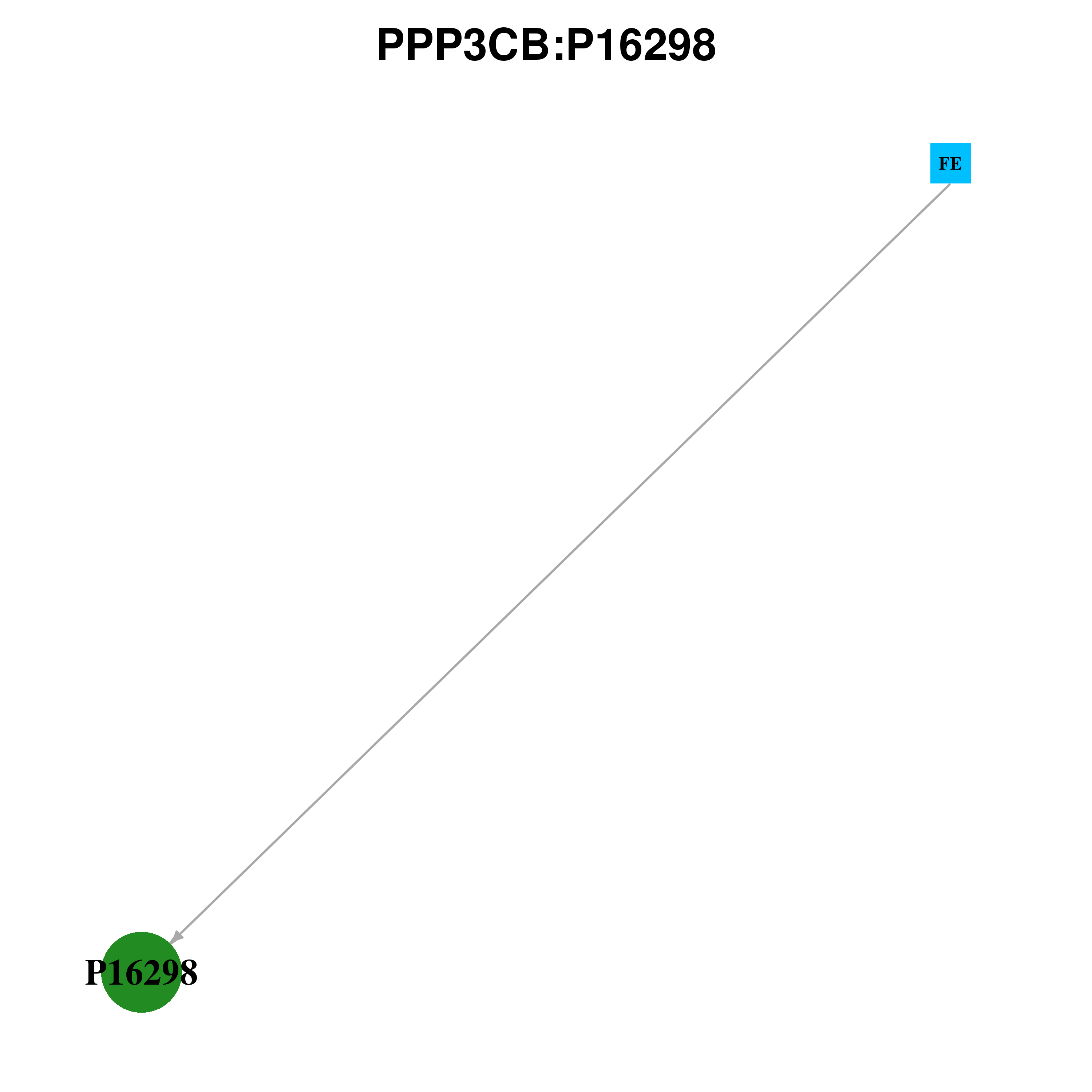| Basic gene Info. | Gene symbol | PPP3CB |
| Gene name | protein phosphatase 3, catalytic subunit, beta isozyme |
| Synonyms | CALNA2|CALNB|CNA2|PP2Bbeta |
| Cytomap | UCSC genome browser: 10q22.2 |
| Type of gene | protein-coding |
| RefGenes | NM_001142353.2,
NM_001142354.2,NM_001289968.1,NM_001289969.1,NM_021132.3,
|
| Description | CAM-PRP catalytic subunitcalcineurin A betacalcineurin A2calmodulin-dependent calcineurin A subunit beta isoformprotein phosphatase 2B, catalytic subunit, beta isoformprotein phosphatase 3 (formerly 2B), catalytic subunit, beta isoformprotein phosph |
| Modification date | 20141207 |
| dbXrefs | MIM : 114106 |
| HGNC : HGNC |
| Ensembl : ENSG00000107758 |
| HPRD : 00235 |
| Vega : OTTHUMG00000018472 |
| Protein | UniProt: P16298
go to UniProt's Cross Reference DB Table |
| Expression | CleanEX: HS_PPP3CB |
| BioGPS: 5532 |
| Pathway | NCI Pathway Interaction Database: PPP3CB |
| KEGG: PPP3CB |
| REACTOME: PPP3CB |
| Pathway Commons: PPP3CB |
| Context | iHOP: PPP3CB |
| ligand binding site mutation search in PubMed: PPP3CB |
| UCL Cancer Institute: PPP3CB |
| Assigned class in mutLBSgeneDB | C: This gene just belongs to mutLBSgenes. |
| cf) Cancer type abbreviation. BLCA: Bladder urothelial carcinoma, BRCA: Breast invasive carcinoma, CESC: Cervical squamous cell carcinoma and endocervical adenocarcinoma, COAD: Colon adenocarcinoma, GBM: Glioblastoma multiforme, LGG: Brain lower grade glioma, HNSC: Head and neck squamous cell carcinoma, KICH: Kidney chromophobe, KIRC: Kidney renal clear cell carcinoma, KIRP: Kidney renal papillary cell carcinoma, LAML: Acute myeloid leukemia, LUAD: Lung adenocarcinoma, LUSC: Lung squamous cell carcinoma, OV: Ovarian serous cystadenocarcinoma, PAAD: Pancreatic adenocarcinoma, PRAD: Prostate adenocarcinoma, SKCM: Skin cutaneous melanoma, STAD: Stomach adenocarcinoma, THCA: Thyroid carcinoma, UCEC: Uterine corpus endometrial carcinoma. |
| LBS | AA sequence | # species | Species |
D127 | YLFLGDYVDRG | 5 | Homo sapiens, Saccharomyces cerevisiae (strain ATCC 204508 / S288c), Drosophila melanogaster, Mus musculus, Rattus norvegicus | D99 | ITVCGDIHGQF | 4 | Homo sapiens, Drosophila melanogaster, Mus musculus, Rattus norvegicus | D99 | ITVCGDIHGQY | 1 | Saccharomyces cerevisiae (strain ATCC 204508 / S288c) | E490 | LDRINERMPPR | 3 | Homo sapiens, Mus musculus, Rattus norvegicus | E490 | HDLINEKLPPS | 1 | Saccharomyces cerevisiae (strain ATCC 204508 / S288c) | E490 | LDAVNERMPPR | 1 | Drosophila melanogaster | H101 | VCGDIHGQFFD | 4 | Homo sapiens, Drosophila melanogaster, Mus musculus, Rattus norvegicus | H101 | VCGDIHGQYFD | 1 | Saccharomyces cerevisiae (strain ATCC 204508 / S288c) | H208 | QFLCVHGGLSP | 3 | Homo sapiens, Mus musculus, Rattus norvegicus | H208 | QYLCVHGGISP | 1 | Saccharomyces cerevisiae (strain ATCC 204508 / S288c) | H208 | QFLCIHGGLSP | 1 | Drosophila melanogaster | H290 | SIIRAHEAQDA | 4 | Homo sapiens, Saccharomyces cerevisiae (strain ATCC 204508 / S288c), Mus musculus, Rattus norvegicus | H290 | SIVRAHEAQDA | 1 | Drosophila melanogaster | N159 | FLLRGNHECRH | 3 | Homo sapiens, Mus musculus, Rattus norvegicus | N159 | WLLRGNHECKH | 1 | Saccharomyces cerevisiae (strain ATCC 204508 / S288c) | N159 | SLLRGNHECRH | 1 | Drosophila melanogaster | Y320 | FSAPNYLDVYN | 4 | Homo sapiens, Drosophila melanogaster, Mus musculus, Rattus norvegicus | Y320 | FSAPNYLDTYN | 1 | Saccharomyces cerevisiae (strain ATCC 204508 / S288c) |
 Gene summary
Gene summary  Gene ontology having evidence of Inferred from Direct Assay (IDA) from Entrez
Gene ontology having evidence of Inferred from Direct Assay (IDA) from Entrez  Cancer type specific mutLBS sorted by frequency
Cancer type specific mutLBS sorted by frequency Relative protein structure stability change (ΔΔE) using Mupro 1.1
Relative protein structure stability change (ΔΔE) using Mupro 1.1  : nsSNV at non-LBS
: nsSNV at non-LBS : nsSNV at LBS
: nsSNV at LBS
 nsSNVs sorted by the relative stability change of protein structure by each mutation
nsSNVs sorted by the relative stability change of protein structure by each mutation  Structure image for PPP3CB from PDB
Structure image for PPP3CB from PDB Differential gene expression between mutated and non-mutated LBS samples in all 16 major cancer types
Differential gene expression between mutated and non-mutated LBS samples in all 16 major cancer types Differential co-expressed gene network based on protein-protein interaction data (CePIN)
Differential co-expressed gene network based on protein-protein interaction data (CePIN) Gene level disease information (DisGeNet)
Gene level disease information (DisGeNet)  Mutation level pathogenic information (ClinVar annotation)
Mutation level pathogenic information (ClinVar annotation)  Gene expression profile of anticancer drug treated cell-lines (CCLE)
Gene expression profile of anticancer drug treated cell-lines (CCLE)
 Drug information targeting mutLBSgene (Approved drugs only)
Drug information targeting mutLBSgene (Approved drugs only) Gene-centered ligand-gene interaction network
Gene-centered ligand-gene interaction network 
 Ligands binding to mutated ligand binding site of PPP3CB go to BioLip
Ligands binding to mutated ligand binding site of PPP3CB go to BioLip Multiple alignments for P16298 in multiple species
Multiple alignments for P16298 in multiple species 
